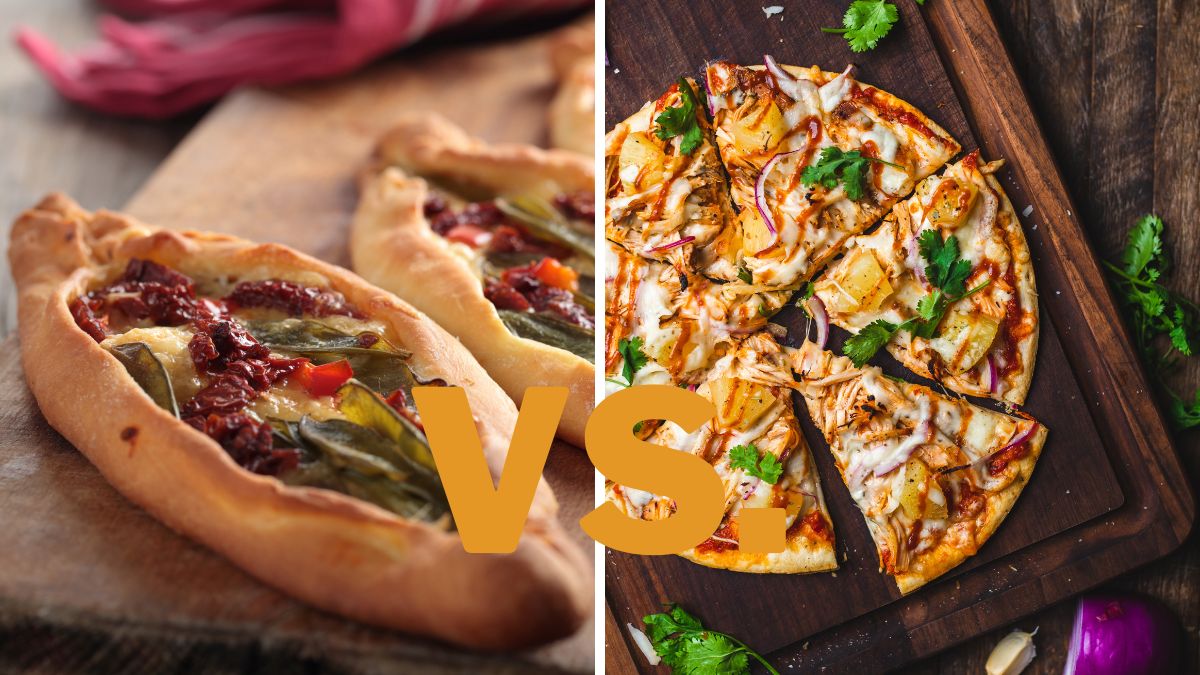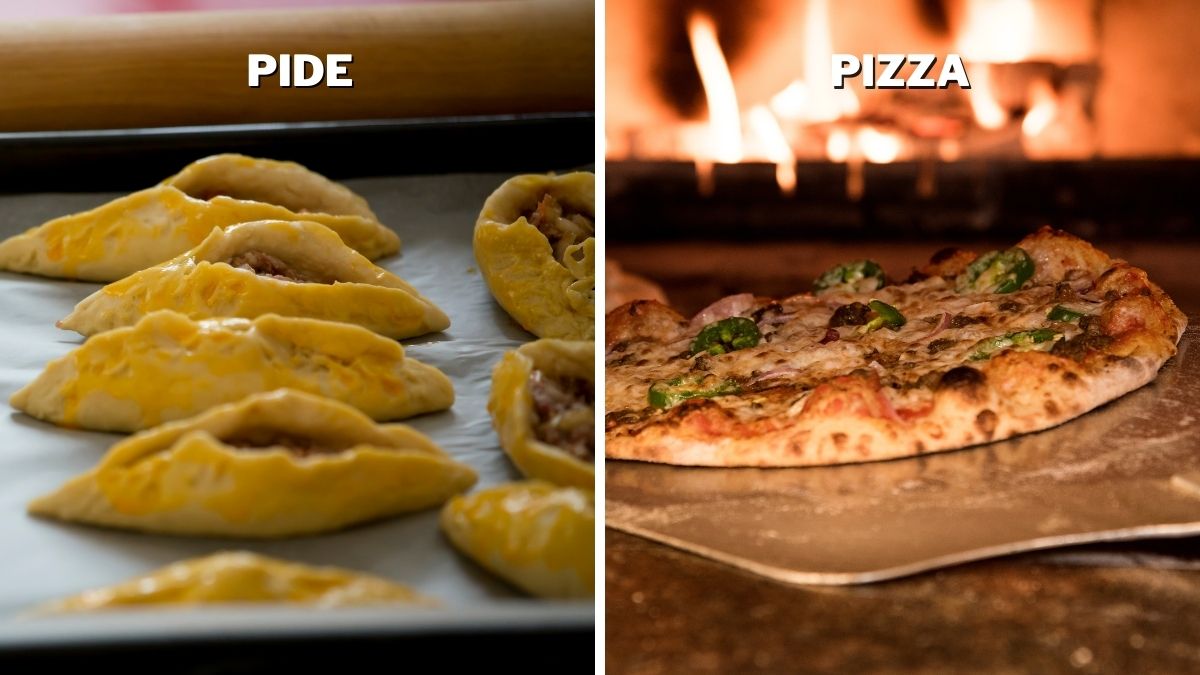Pide vs. Pizza: Differences Explained

Pide and pizza are Mediterranean-induced savory pastries, with pretty much the same crust. They are both crunchy, cheesy, and trés delicious. If you’re bored of good old pizza, try to make this very similar, but still very different meal. There are countless variations for both of these, so I love to experiment and try different fillings. And trust me, the only-cheese one is a bit boring when you see all those options. So, what’s the difference between pide and pizza?
Circular pizza and boat-shaped pide have the same crust, but the first one is thinner than the other. Pide is quite spicy, rich, and usually packed with different meat. Pizza fancies cheese and cold cuts, but pide goes for creamy sauces. Moreover, pide is also buttery, while pizza isn’t.
I love experimenting with different foods, so following this, the Middle East is a real treasure. It’s funny to see how similar ingredients make poles apart meals. Here is a not-so-little list of their differences (and resemblances) to find out more about these amazing pastries. Let’s find out about their origin, appearance, dough, fillings, servings, and much more!
Origin
Pizza originates from Naples, Italy, while pide comes from Turkiya, Ottoman Empire more precisely. History says pide is the first one to be invented, but pizza is more popular in the world nowadays. People in the West usually call pide a Turkish pizza, but knowing this fact, it kinda feels inaccurate.
Appearance
There is probably no person who doesn’t know what pizza looks like. Traditional Italian pizza is round and thin, while the American version is a bit thicker. It’s always cut into triangles of happiness, though. There is just a bit of crust on the edges, as the rest is covered with delish toppings.
When it comes to pide, it has a more unique look. It is technically a long and oval flatbread. The filling is in the middle, and the edges are folded inside. Plus, you need to pinch or twist both ends to form a boat-like signature shape. As you can see, there is more un-topped crust here, but still as delicious.

Dough
The ingredients for the dough are exactly the same in both pizza and pide. The difference is texture and thickness. Pide has softer and more tender consistency, as it needs to be thicker than a pizza, but it’s still thin.
The reason for this is the heavier filling which is concentrated in the middle, so something has to hold it in one place. Also, the edges are chunkier, so they have a more bread-like texture. On the other hand, pizza is chewier, crustier, and crunchier.
One more thing, you can crack an egg on the top of your pide while it’s still cooking and sprinkle it over with seed mixes, like sesame and flax seeds. This is a cherry-on-top moment when it comes to pide, and I really love it.
Filling and Spices
The chief difference in toppings is that on pide, the sauce is part of the filling, while on pizza, it’s one of the toppings. Staple ingredients for pizza are cheese, deli meat, and vegetables. Let’s explain what this means!
Pide fillings go from creamy meat sauces to simple cheese and spinach. The most popular are minced meat sauce, diced meat sauce, eggs, sujuk, pastrami, lamb, and much more! These are obviously more versatile than pizza toppings.
But there is one topping you rarely skip when making any of these pastries, and that’s cheese, of course. While mozzarella and parmesan are the number one options for pizza, Turkish kasar is chief for pide. Kasar and mozzarella have a similar texture, though, so you can easily change one for the other.
Being an East-induced meal, pide is way richer in spices. Pizza spices are pretty much herbs: oregano, basil, and thyme, which take it from boring to delicacy. But, when it comes to pide, there are much more typical flavors.
Pide fillings tolerate loads of different relishes, especially meat-based ones. Here are some top-tier seasonings that make a famous Turkish spice mix: paprika, garlic powder, cilantro, mint, turmeric, cumin, pepper, smoked paprika, chili flakes, and many more.

Taste
The dough tastes quite the same, with olive oil as the most prominent taste and aroma. Everything else depends solely on the toppings you use. As tomato sauce is the statement ingredient when making pizza, it always has a slightly acidic flavor as a base.
In any case, the cheese is melted to perfection because heating intensifies its umami flavor. Of course, if you use mozzarella the pizza will have floral notes with a touch of tang. If you want a sharper, nuttier taste, go for parmesan or pecorino.
Meat sauces you fill your pide with are always spicy, earthy, and warm. That’s the signature relish of the Turkish spice blend or tangy and sharp if you go for a feta-spinach combo. Overall, the main pizza flavors come from tomato sauce and cheese, but when it comes to pide, everything revolves around spices!
Preparation Method
The preparation method starts the same, by kneading. When rolling out the pizza dough, you’re going for a circular shape, but for pide it’s elliptical. There is one more step after rolling out the dough for pide, and that’s shaping, unlike pizza.
When preparing pizza, you only have a tomato sauce to cook in advance, while many fillings for pide require cooking ahead of time. When making sauces, the key is to keep the meat deliciously tender and succulent. You can achieve that texture only by slow cooking it in loads of spices and condiments.
That means some of them call for cooking like regular sauces but slightly more reduced. You obviously need more time to prepare it than regular pizza, but it’s worth it!
While pide is baked in the oven, traditional pizza is baked in the woodfire oven.

Serving Style
Both pide and pizza are served anywhere, from fancy restaurants to street food. When served in the restaurant, pizza usually comes topped with fresh arugula or basil as decoration. Typically, pide has no toppings or just a few leaves of mint.
Street pizza is served in slices, but pide comes in mini sizes. Just a regular pide, but smaller, easy to eat on the go — I really adore these; they look and taste amazing! What’s more, there is another extreme – pide can be really long, even a meter! In that case, there are a few different toppings in one pide, similar to pizza.
Also, what differentiates pizza and pide is butter. Butter is a staple ingredient when it comes to serving pide, as it’s best to brush the crust while it’s still hot. Whether you’re using simple salted butter or some herb-garlic mixture, everything works just fine!
The egg on top is a common thing for pizza and pide, but while you eat that pizza typically, there is one trick when it comes to pide. You cut the pointy ends and dip them into an egg. The yolk needs to be runny in both, though.
While the pizza goes best with a coke or a glass of wine if you want to be fancy, pide’s perfect match is ayran (a yogurt-based drink). You can also serve it on a bed made of salad, spring onion, cucumber, and lemon wedges. The heavy relishes of meat need something fresh and acidic to smash it.
Variations
There are numerous variations in both meals. It goes from raw to industrial and everything in between. There are recipes for raw pizza, with ground seeds and nuts, but pide can’t be made with something like this. You need to use regular flour, but you can definitely mix up a few different types.
When speaking of filling, pide is famous because of its spicy, rich, and meaty sauces. If you want something more Mediterranean, go for spinach, olives, and mozzarella. The most famous pides are stuffed with lamb meat, beef, and sujuk.
On the other hand, Margherita – cheese-only pizza — is the best-loved around the world. Tuna fish, vegetable only, cold-cuts, and pineapple are also toppings you must try! You can also fold the pizza dough and make a pizza sandwich out of it!
Popularity
Pizza became popular in the 1940s when Italian immigrants came to America. It only gained popularity over the decades and became probably the most loved meal around the globe. Then again, pide is very popular in the Middle East, but not so much in the West. This should definitely be changed, don’t you think?
To sum up, here is the table that will help you understand the differences between pizza and pide:
| Pizza | Pide | |
|---|---|---|
| Origin | Italy | Turkey |
| Appearance | circular | boat-shaped |
| Dough | crispy and thin | bread-like texture, fluffy in the middle, crispy on the edges |
| Filling | cheese, cold cuts, tomato sauce | meat: lamb, beef, chicken; sujuk, cheese, vegetables |
| Prep-methods | everything bakes at once | sometimes you need to cook the sauce in advance |
| Decoration | arugula, basil | mint |
| Spices | sea salt, oregano, basil | Turkish spice blend |
